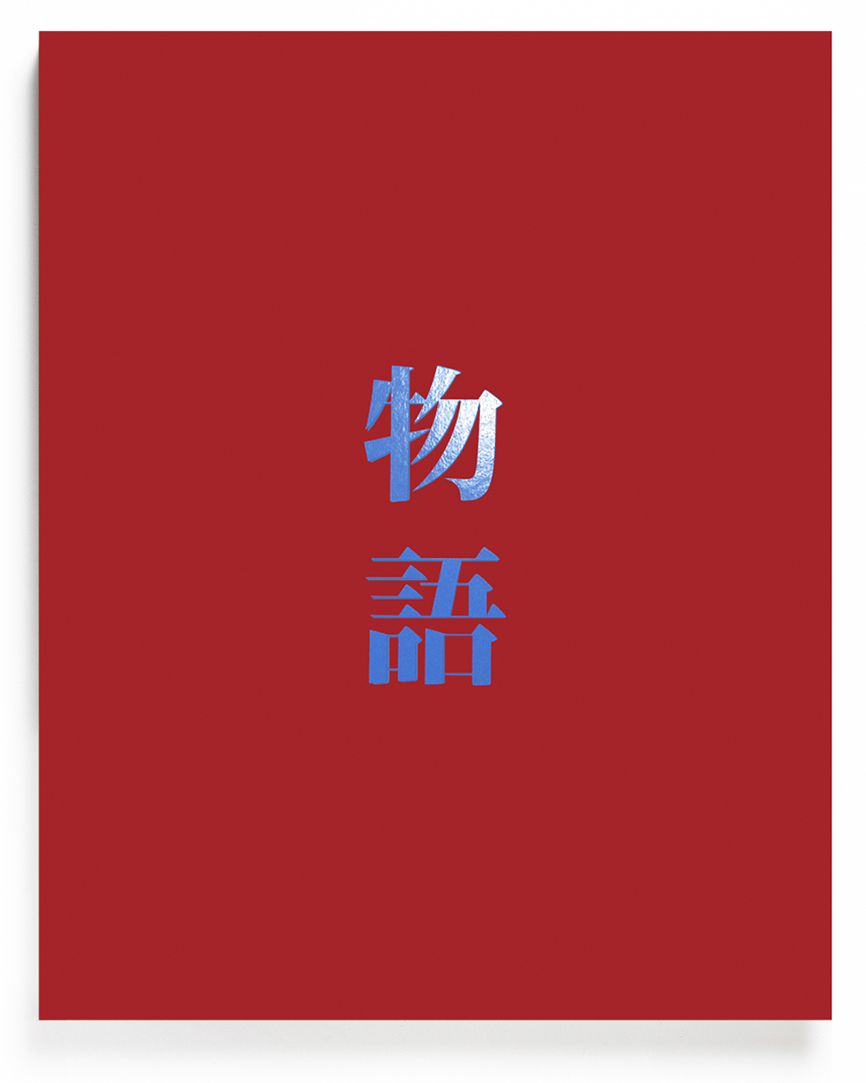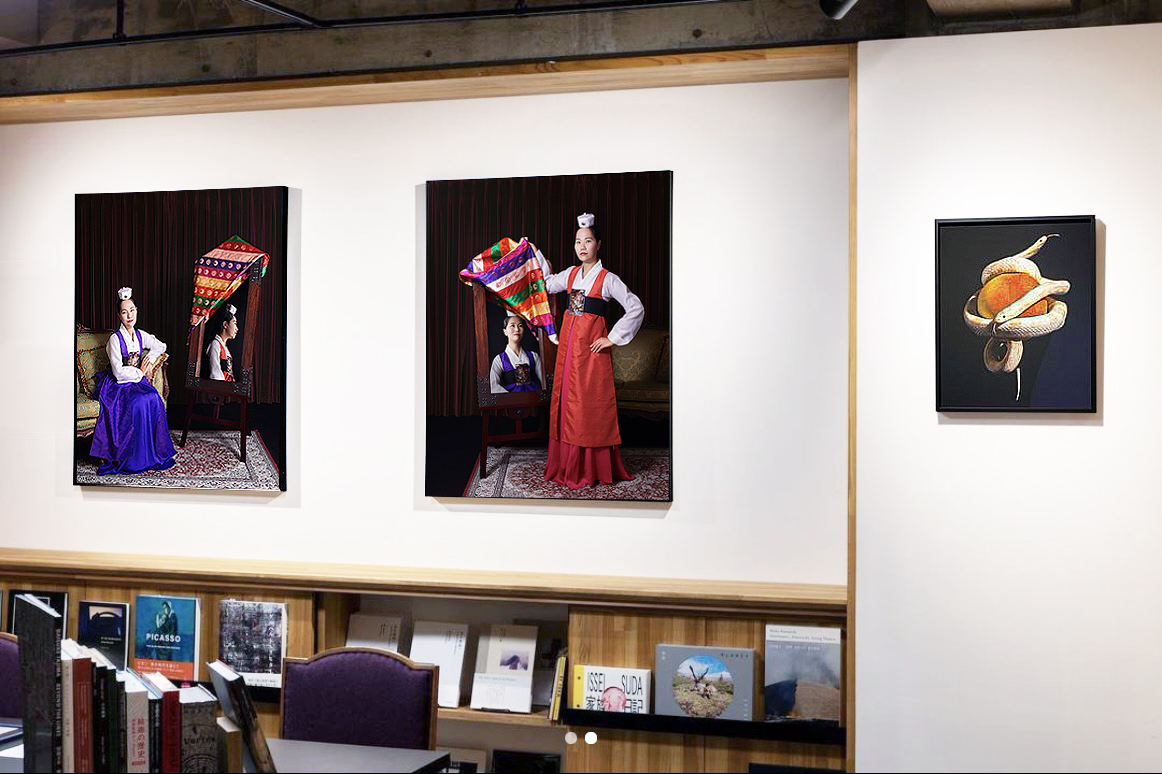
金サジ『物語』
発行:赤々舎 Size: H320mm × W257mm Page:120 pages Binding:Hardcover(codex) Published in December 2022 ISBN:978-4-86541-161-4 |
¥ 5,500+tax
国内送料無料! お支払い方法は、銀行振込、郵便振替、 クレジットカード支払い、PayPal、PayPay よりお選び頂けます。 |
|---|
About Book
トラウマと向き合い、魂を解き放つ、ハイブリッドな物語空間。
Story 이야기
Kim Sajik 김사직
"In Story, Kim Sajik takes us on a mythical journey through the soul. Like the androgynous child muse figure whose gaze meets ours at the beginning and end of this collection of photographs, it is as if the artist herself is a trickster who stands at the edge of another dimension and beckons us in. In the mythology of all world cultures, a trickster is a figure who can cross boundaries and travel between dimensions. Here, she bends the rules and the established order of dominant narratives in order to dive deeply into important questions about identity, hybridity, gender, and existence.
As a third-generation Korean immigrant to Japan (Zainichi Korean), Kim uses her art to address the intersecting traumas of colonialism, war, cultural displacement, and subjugation. This is an alternate dream universe, inflected with the "stories" of intergenerational wisdom and experience passed from mothers to daughters, through waves of Korean migration to Japan; yet it is also a surreal and often playful depiction of universal themes that speak to the shared, global human experience of survival and resilience in the face of unspeakable violence. Though there are obvious hints of Korean iconography in her work, her imagery is in fact an elaborately imagined cosmos of hybridity hewn from the visions of her dreams. Even the clothing and adornments worn by the figures in these images are neither traditionally "Korean" nor belong to any ethnic group; they are entirely the creation of the artist. Like the collective unconscious about which Jung wrote extensively, there is an archetypal nature to these images that traces the mysteries of birth, life, light, darkness, death, and rebirth. But in some ways, Story is a self-portrait of the artist herself, a personal dream world in which pine trees speak of omens and earthquakes are the outcome of the earth and the sky making love.
In this other dimension, our earth has emerged from a violent disturbance in the proverbial timeless cosmic cycle of egg versus chicken. The world has spilled from the neck of this decapitated chicken, and the land, puckered with inflamed wounds, is a vast lava field, bleeding like exposed viscera. A great eternal pine tree towers over this planet, her branches resembling human limbs and bones, passing wisdom from generation to generation, auspicious pinecones exploding and spawning, planting seeds for more life. Animal and plant deities guard over this abundant planet. A womb, hewn of bark and feathers, comes into view--merging of sky and earth. Two female twins are born to a woman who prays for children deep in a forest. They are blessed by sanshin harumoni, the grandmotherly guardian goddesses of childbirth, and watched over by natural spirits, but also haunted by evil ogres. In two mirror-image self-portraits of the artist, we watch how these twins each grow up into young women whose worlds contradict--torn apart by the colonial violence of patriarchal power on one hand and the maternal, primordial forces of nature on the other. Citing Renaissance-era paintings of the biblical battle between Cain and Abel, the artist portrays the brutal struggle between these sisters as a representation of her own intergenerational identity struggle between Korea and Japan [...]
Yet, this mythical journey leads beyond death and towards rebirth, through song and celebration, through rituals of new beginnings. For the artist, the boat that carries the soul to another realm is not just a vehicle but a companion who walks with the dead. And from the shells of myriad cicadas, a lotus flower breaks through the surface, in an allusion to the endless Buddhist cycle of samsara. [...]
Inspired not only by traveling and encountering fairy tales passed down from elders, many of these scenes were imagined from Kim's own sense of embodied knowledge gleaned from rehearsing traditional Korean dances that have been reinterpreted by successive generations of Zainichi Korean immigrant communities in Japan. She celebrates the body in all its rawness, honoring women's bodies' deep links to land and nature, as agents of creation. As a dancer, she recuperates in her own body the memory of previous generations while also embracing the shifts, ruptures, and transformations that have come about through trauma and contradictory contexts. Her photographs, many of which are self-portraits of her own body, celebrate the complexity of these postcolonial identities, not shying away from the brutal wounds of war and colonial subjugation, and the ensuing sense of disorientation and displacement. [...]
Emphasizing the power of women, the male protagonists who appear in Story are faceless, with the exception of those who are dead or social outcasts. The figure of the man who has beheaded the cosmic chicken, the holy man who imposes his religion, the groom who marries one of the twins, the invading colonist who sits proudly with his rifle upon the skin of a slain tiger--each of these characters and many others have their faces obscured from view. Most conventional nationalistic histories around the world, especially those of colonization and war, highlight only the names and faces of male heroes. By exposing the struggles and contributions of women, Kim reverses this erasure and calls attention to matrilineal heritage and continuity. She also shows how in many ways, the patriarchal violence carried out by men--such as Japanese imperial military atrocities and harsh, racist colonial rule--was often carried out by "faceless" actors who were never held accountable for their crimes. Rather than blame all men for these traumatic trespasses, Kim shows how the ideology of gender itself can result in the perpetuation of harm. [...]
Story is a ceremonial dimension that attempts to soothe the wounds of colonialism and recuperate stolen memories and roots. As Kim Sajik herself points out, rituals are liminal moments when unexpected, even absurd events take place, and yet we fully accept these otherworldly experiences without even really understanding what has just taken place. Shamanistic rituals often entail puzzling, enigmatic elements that remove us from our everyday realities and allow us to think in new and refreshing ways. By invoking the magical space of ritual and shamanism, the artist thus infuses fresh "trickster energy" into the painful, heavy memories borne by the Korean diaspora of Japan, lighting up the darkness, reclaiming history, and opening up new possibilities for healing."
Extracted from the text "Tricksters and Trauma"
Greg Dvorakr
(Professor of Pacific and Asian history and gender studies, Waseda University)
Related Exhibiton
金サジ「『物語』シリーズより 山に歩む舟」 会期:2022年10月27日(木) 〜11月14日(月) 時間:13:00〜20:00(土日11:00〜19:00 水休) 会場:PURPLE(京都市中京区式阿弥町122-1 3F) 入場:500円 文化庁「ARTS for the future! 2」補助対象事業 金サジ「物語」シリーズより:山に歩む舟 当事者性ということ(REALKYOTO FORUM レビュー)|文:清水 穣 金サジ「物語」シリーズより:山に歩む舟(artscape レビュー)|文:高嶋慈 |
Artist Information
金サジ
自身のコリアンディアスポラの身体的、精神的アイデンティティの「揺らぎ」をきっかけとして活動をはじめる。創作物語を演出写真の技法を用いて作品を制作。写真家として活動しながら、活動の一環として、韓国舞踊家、金一志の下に師事。韓国伝統芸能を学びながら、ディアスポラに代々継承されていく歴史・民族精神のトラウマから生まれる新たな可能性を探っている。現在、ロシアのサハリンのリサーチを日本サハリン協会等の協力を得ながら継続中。2020年度より多様なメンバーと映像作品「AMA~ウィルスとおよぐ~」を完成に向けて奮闘制作中。2016年度キヤノン写真新世紀グランプリ、令和3年度京都府文化賞奨励賞受賞。
Kim Sajik
Born in Kyoto. The swaying her own Korean diaspora's physical and mental identity have driven her to work. she creates works using the technique of staged photography of her creative narratives. As part of artist's activities, she studied under the Korean Butoh dancer, Kim Iru Chi. While studying traditional Korean performing arts, she is exploring new possibilities that arise from the trauma of historical and ethnic spirituality passed down from generation to generation in the diaspora.she recived the Grand Prize in 2016 Canon's New Cosmos of Photography competition and 2021Kyoto Prefecture Cultural Prize,Encouragement Award.
2014 "Busan Biennale 2014 Special Exhibition Asian Curatorial" (Busan,Korea)
2016 "Art Court Frontier 2016 #14", Art court gallery (Osaka,Japan)
2017 "the Night of a Full Moon, a Man Builds a Grave and a Woman Eats Pinecones." TOKYO PHOTOGRAPHIC ART MUSEUM (Tokyo,Japan)
2017 "showcase #6 "Storytelling" curated by minoru shimizu" eN arts (Kyoto,Japan)
2017 "Ascending Art Annual Vol.1「Shapes and Figures」"Spiral(Tokyo,Japan),WACOAL STUDYHALL (Kyoto,Japan)








